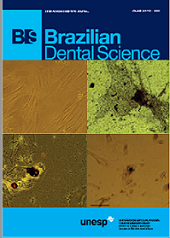Prevalence of temporomandibular disorder and its association with stress and anxiety among university students
DOI:
https://doi.org/10.14295/bds.2020.v23i1.1810Resumo
Objective: The objective was to evaluate the prevalence of Temporomandibular Disorders (TMD) and the association with stress and anxiety among university students. Material and Methods: The Fonseca Anamnestic Index, Trait-State Anxiety Inventory (IDATE) and LIPP Stress Symptom Inventory (LIPP) were applied for 714 voluntaries. Descriptive and inferential statistical analyzes were performed using the chi-square or Fisher's exact test and the Student's t-test or ANOVA, significance level of 5%. Results: The prevalence of TMD was 68.63%, 46.9% had mild TMD. There was a statistically significant difference between the means of age and the severity of the TMD, higher mean values for severe TMD (22.5 ± 3.3 years). There was a statistically significant association between the female and TMD, higher prevalence of mild TMD. Among the volunteers diagnosed with TMD, a significant number were diagnosed without stress, but there was a statistically significant association between those diagnosed with stress and mild TMD, anxiety and TMD, (state: moderate anxiety and DTM - 50%; trait: moderate and severe anxiety and mild DTM - 49.3% and 49.87%, respectively). Conclusion: There was a high prevalence of TMD signs and symptoms, with higher prevalence in the female gender, mild TMD was more significant, and anxiety and stress were significantly present among university students with TMD signs and symptoms.
Keywords
Temporomandibular disorder; Anxiety; Psychological stress.
Downloads
Downloads
Arquivos adicionais
Publicado
Como Citar
Edição
Seção
Licença
TRANSFERÊNCIA DE DIREITOS AUTORAIS E DECLARAÇÃO DE RESPONSABILIDADE
Toda a propriedade de direitos autorais do artigo "____________________________________________________________________" é transferido do autor(es) para a CIÊNCIA ODONTOLÓGICA BRASILEIRA, no caso do trabalho ser publicado. O artigo não foi publicado em outro lugar e não foi submetido simultaneamente para publicação em outra revista.
Vimos por meio deste, atestar que trabalho é original e não apresenta dados manipulados, fraude ou plágio. Fizemos contribuição científica significativa para o estudo e estamos cientes dos dados apresentados e de acordo com a versão final do artigo. Assumimos total responsabilidade pelos aspectos éticos do estudo.
Este texto deve ser impresso e assinado por todos os autores. A versão digitalizada deverá ser apresentada como arquivo suplementar durante o processo de submissão.




























